This document accompanies the SIGGRAPH
2004 paper that describes a factored BRDF representation useful
for efficient importance sampling. Here, we provide the data used to
generate Figure 10 in the hope that future researchers will be able to
reproduce these results for improved evaluation of their own method.
This document contains the followint items:
- The images from Figure 10
rendered with a distribution path tracer that generates incoming
directions for Monte Carlo estimation of scene radiance using (1) a
best-fit Lafortune model and (2) our factored representation of the
target BRDFs in the scene. We show rendered images for both
strategies at equal sample counts of 40, 100, 300, 600 and 1200. The
Lafortune strategy requires roughly 4x the number of samples to
achieve the same quality as the factored BRDF representation.
- The materials in the scene
consist of 2 analytic BRDF models and 3 measured BRDF models from the
Matusik
dataset. We provide the factored representation of each BRDF along
with their numerical Cumulative Distribution Functions (CDFs) for
sampling. We also provide the parameters from a multi-lobe Lafortune
model we fit to each BRDF using the non-linear Nelder-Mead simplex
searching algorithm. In ease case, we used an equal number of samples
of the original BRDF in both the factored representation and as the
target dataset during the non-linear fit of the Lafortune model. We
fit a 3-lobe (2 specular lobes + 1 diffuse lobe) Lafortune model to
the Cook-Torrance BRDFs and a 2-lobe (1 specular lobe + 1 diffuse lobe)
to the measured BRDF models. We used the techniques described in the
Lafortune
paper to sample these analytic BRDFs efficiently. We have also
prepared notes
on reconstruction and sampling of our factored BRDF representation.
- The geometry in the scene along
with each object's associated material index. These triangle meshes
are binary PLY files.
- The camera parameters used to
image the scene.
- The illumination in the
scene.
- A brief analysis of why
sampling a best-fit Lafortune model performs so poorly for some of the
BRDFS in this scene as compared to the factored representation.
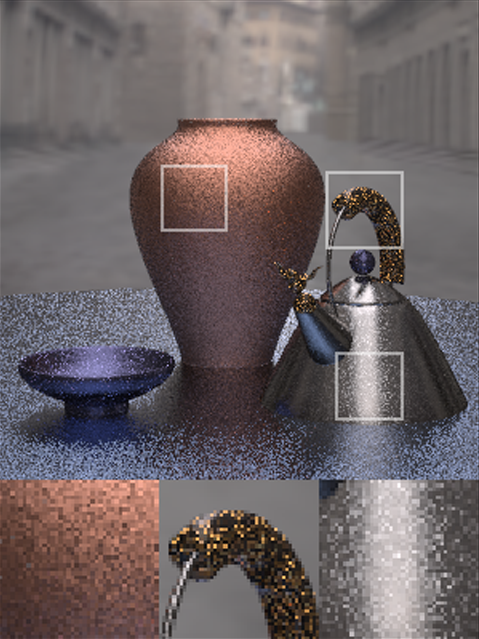
Lafortune Sampling (40 Samples) |
|
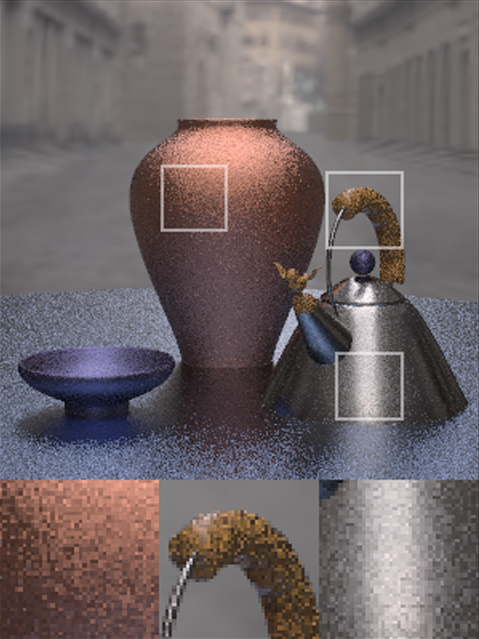
Factored Sampling (40 Samples) |
|
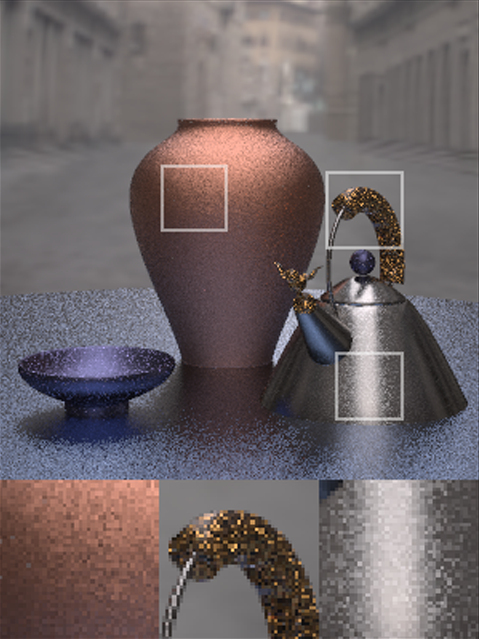
Lafortune Sampling (100 Samples) |
|

Factored Sampling (100 Samples) |
|
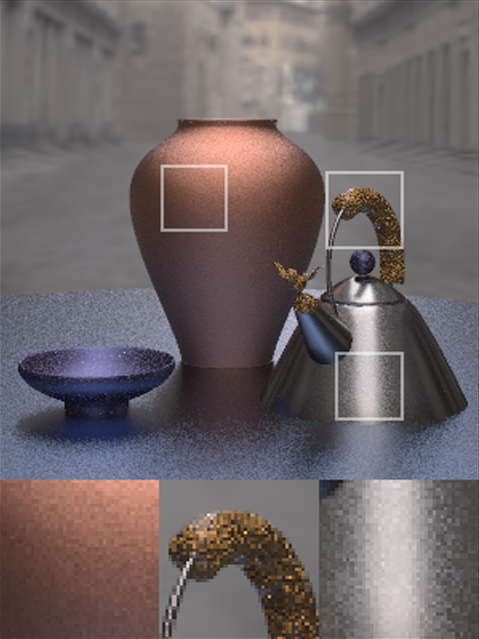
Lafortune Sampling (300 Samples) |
|
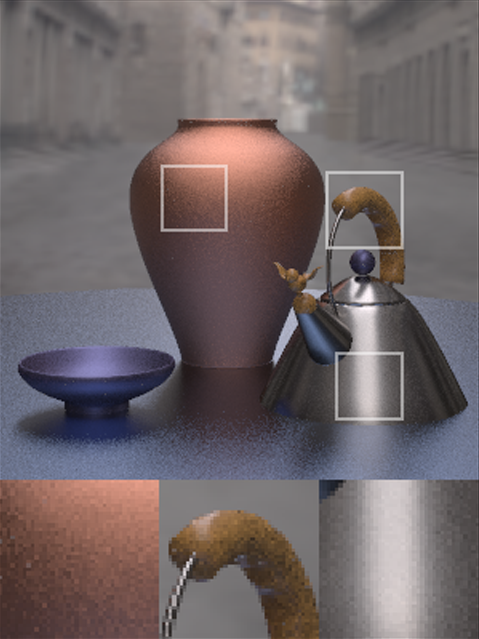
Factored Sampling (300 Samples) |
|

Lafortune
Sampling (600 Samples) |
|
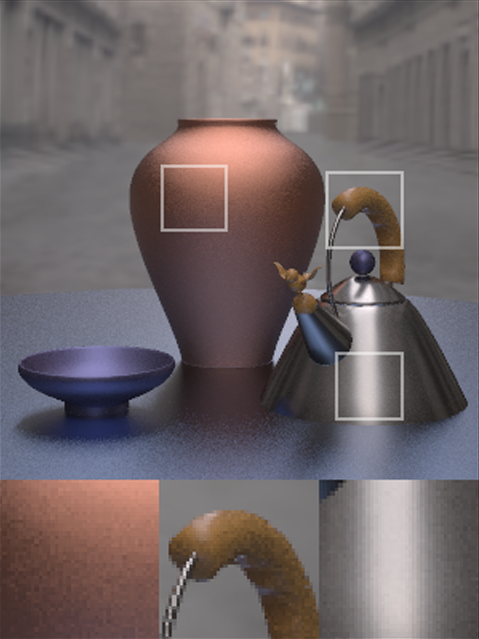
Factored Sampling (600 Samples) |
|
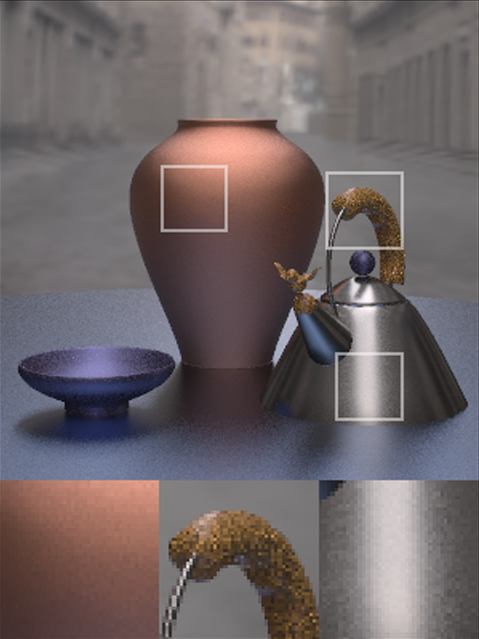
Lafortune Sampling (1200 Samples) |
|
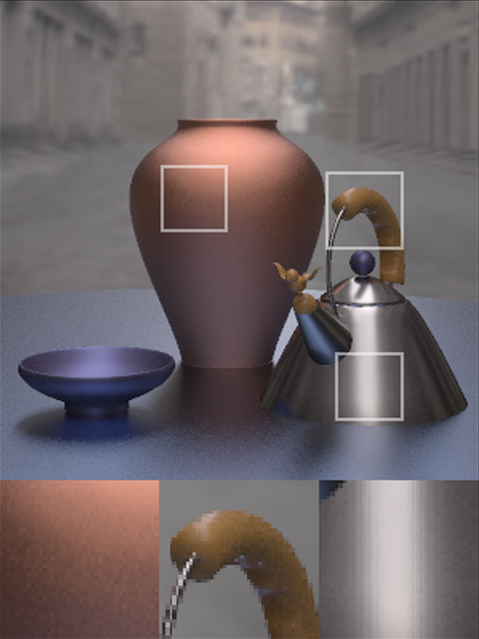
Factored Sampling (1200 Samples) |
|
| #1: Analytic Cook-Torrance BRDF---d=0.0, s=0.2, std=0.15, F_0={0.12,0.22,0.48} |
Lafortune Fit |
Factored (description) CDFs (description) |
|
| #2: Analytic Cook-Torrance BRDF---d=0.0, s=0.2, std=0.4, F_0={0.68,0.22,0.12} |
Lafortune Fit |
Factored CDFs |
| #3: Measured Metallic-Blue BRDF |
Lafortune Fit |
Factored CDFs |
| #4: Measured Nickel BRDF |
Lafortune Fit |
Factored CDFs |
| #5: Measured Plastic BRDF |
Lafortune Fit |
Factored CDFs |
- eye = (20.736, 3.9952, 0.3)
- ref = (0.0, 1.9952, 0.3)
- up = (0,1,0)
- x-fov = .1963495
|
|
We use image-based illumination in this scene: the Uffizi environment
captured by Paul Debevec.
|
|
One reasonable approach to sampling complex parametric or measured
BRDFs is to compute a best-fit analytic BRDF that can be sampled
directly. One such analytic BRDF is the Lafortune
model. To explain why this strategy performs so poorly as
compared to using our factored representation for certain BRDFs we use
the measured nickel BRDF in this scene as an example. In this case,
we fit a 2-lobe (1 diffuse lobe + 1 "specular" lobe) Lafortune model
to the original BRDF sampled at the same resolution as the factored
approximation. Below we show false-color image visualizations (on a
logarithmic scale) of the shape of the original BRDF, the best-fit
Lafortune model and our factored representation for normal incidence
and near-grazing incidence (elevation angle = 89 degrees from normal).
These images give evidence that the Lafortune model is unable to
effectively match the shape of the original BRDF and, consequently,
sample it efficiently. |
|
In this case, its the restricted parameterization of the incoming
hemisphere that the Lafortune model allows that limits its
effectiveness. Simply put, the parameterization that the Lafortune
model provides is roughly of the "R dot V" variety. For these BRDFs,
this is not appropriate for the shape of the specular lobes. These
BRDFs are better parameterized by "H dot N" which is the
parameterization we selected to use for the factored representation.
This illustrates why providing arbitrary parameterizations of the
incoming hemisphere (e.g. both "R dot V" and "H dot N"), which the
factored representation does allow, is critical for efficient
representation of a wide variety of BRDFS.
|
|
In addition to parameterization, these 2D slices of the three BRDFs
suggest the flexibility a numerical approximation provides over
fitting a rigid, non-linear model to the original data. Large
variations in the shape of the BRDF are better matched by the factored
representation which directly approximates the fully tabulated BRDF
over the incoming/outgoing directions considered. This flexibility
results, in part, from the NMF algorithm computing a set of "basis
images" (G_j in the paper) and "mixing weights" (F_j) specifically
geared toward optimally approximating the set of BRDF slices contained
in the original data matrix. This key difference between the factored
representation and the Lafortune model would be true with any best-fit
parametric model in most cases, even if it provided a more appopriate
parameterization of the incoming hemisphere. |
|
Taken together, this BRDF demonstrate the potential usefulness of a
general, numerical approach to factoring BRDFs for the purpose of
importance sampling. We refer to the paper for
a more detailed comparison between sampling this factored
representation and other best-fit analytic BRDF models.
|
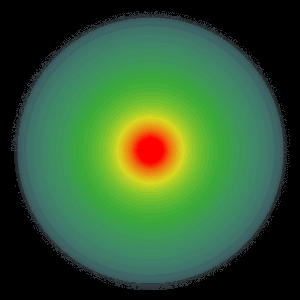 | 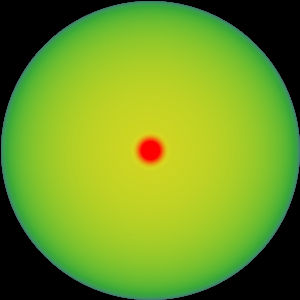 | 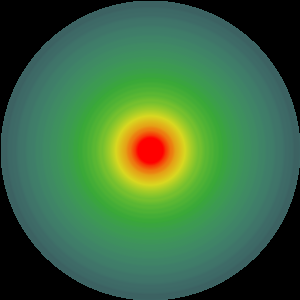 |
| Measured Nickel BRDF (normal incidence) |
Lafortune (normal incidence) |
Factored (normal incidence) |
|
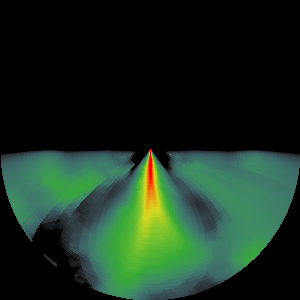 | 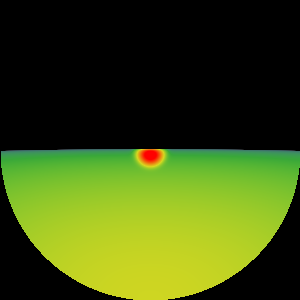 | 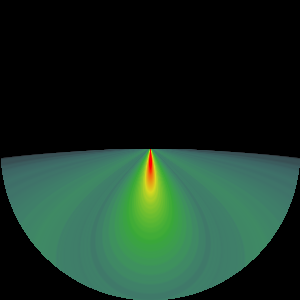 |
| Measured Nickel BRDF (elevation = 89 degrees from normal) |
Lafortune (elevation = 89 degrees from normal) |
Factored (elevation = 89 degrees from normal) |
|
|
These images are false-color visualizations of the logarithm of
the values of the BRDF for a dense set of incoming directions at a
fixed view. Each column corresponds to the original measured BRDF,
the best-fit Lafortune BRDF as computed by the Nelder-Mead non-linear
optimization algorithm and our factored representation (from left to
right in that order). The top row of images are slices of these BRDFS
for a normal view direction. The bottom row of images are slices at
near grazing angle (i.e. the view is 89 degrees from normal). Some
measurement noise is apparent at this grazing view (although it is
largely exaggerated by the logarithmic transformation) and half of the
incoming hemisphere is clipped by the horizon. The main thing to
notice is how the Lafortune BRDF is unable to accurately represent the
overall shape of the directional-diffuse lobe in this BRDF over
its entire domain. The non-linear optimizer compensates for this by
increasing the diffuse component of the BRDF in order to reduce the
overall error of the fit. For sampling, these consequences are severe
at grazing angles, where the actual specular lobe is undersampled in
regions of high energy (producing bright white spots) and oversampled
primarly in its diffuse component. For more specular materials (such
as the measured plastic BRDF in our scene), this compensation is even
more substantial, drastically reducing the sampling efficiency
provided by a best-fit Lafortune BRDF. Even if this fit had been
manually tuned to provide a more "defensive" sampling pattern it could
never match the exact shape of the target BRDF nor is this manual
tuning an easy process. For this reason, we argue that there are many
BRDFs (such as those in Figure 10 of this paper) for which a general,
numerical sampling approach is desirable.
|
|

